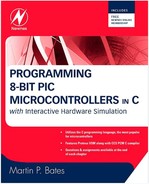Foreword
Embedded microcontrollers are everywhere today. In the average household you will find them far beyond the obvious places like cell phones, calculators, and MP3 players. Hardly any new appliance arrives in the home without at least one controller and, most likely, there will be several—one microcontroller for the user interface (buttons and display), another to control the motor, and perhaps even an overall system manager. This applies whether the appliance in question is a washing machine, garage door opener, curling iron, or toothbrush. If the product uses a rechargeable battery, modern high density battery chemistries require intelligent chargers.
A decade ago, there were significant barriers to learning how to use microcontrollers. The cheapest programmer was about a hundred dollars and application development required both erasable windowed parts—which cost about ten times the price of the one time programmable (OTP) version—and a UV Eraser to erase the windowed part. Debugging tools were the realm of professionals alone. Now most microcontrollers use Flash-based program memory that is electrically erasable. This means the device can be reprogrammed in the circuit—no UV eraser required and no special packages needed for development. The total cost to get started today is about twenty-five dollars which buys a PICkit™ 2 Starter Kit, providing programming and debugging for many Microchip Technology Inc. MCUs. Microchip Technology has always offered a free Integrated Development Environment (IDE) including an assembler and a simulator. It has never been less expensive to get started with embedded microcontrollers than it is today.
While MPLAB® includes the assembler for free, assembly code is more cumbersome to write, in the first place, and also more difficult to maintain. Developing code using C frees the programmer from the details of multi-byte math and paging and generally improves code readability and maintainability. CCS and Hi-Tech both offer free “student” versions of the compiler to get started and even the full versions are relatively inexpensive once the savings in development time has been taken into account.
While the C language eliminates the need to learn the PIC16 assembly language and frees the user from managing all the details, it is still necessary to understand the architecture. Clocking options, peripherals sets, and pin multiplexing issues still need to be solved. Martin's book guides readers, step-by-step, on the journey from “this is a micro-controller” to “here's how to complete an application.” Exercises use the fully featured PIC16F877A, covering the architecture and device configuration. This is a good starting point because other PIC16s are similar in architecture but differ in terms of IO lines, memory, or peripheral sets. An application developed on the PIC16F877A can easily be transferred to a smaller and cheaper midrange PICmicro. The book also introduces the peripherals and shows how they can simplify the firmware by letting the hardware do the work.
MPLAB®, Microchip's Integrated Development Environment, is also covered. MPLAB includes an editor and a simulator and interfaces with many compilers, including the CCS compiler used in this book. Finally, the book includes the Proteus® simulator which allows complete system simulation, saving time and money on prototype PCBs.
Dan Butler
Principal Applications Engineer
Microchip Technology Inc.
